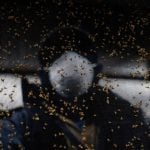Genomics isn’t new to agriculture, but only recently has it made its way to beef cattle.
The study of genetic material from environmental samples has changed the way crops are bred, disease is addressed and animal genetics are understood.
In beef cattle, genomics research has started in disease diagnostics and the understanding of disease, bacteria and viruses.
Read Also

Cancer agency reclassifies another herbicide ‘probably carcinogenic’
The WHO’s cancer research agency has now put atrazine, a herbicide well known to corn growers, in the same potential-hazard category where the agency put glyphosate.
Cheryl Waldner, a professor and researcher at the Western College of Veterinary Medicine at the University of Saskatchewan, is among those working on metagenomics research in beef cattle and is specifically looking into bovine respiratory disease.
Her work at the Livestock and Forage Centre of Excellence (LFCE) as part of the Canadian Cow-Calf Surveillance Network is a precursor to research enabled by new facilities at the U of S and LFCE.
Currently, in disease diagnostics, a sample undergoes a targeted test (most commonly, PCR) for a suspected disease. A PCR diagnosis detects specific genetic material such as DNA or RNA. However, it tests for one disease at a time.
“I can’t find a bug if I don’t know what I’m looking for most of the time,” Waldner told the LFCE 2025 Field Day. “I might stumble on it by accidental culture, but unless I’ve got a plan … they’re probably going to miss it.”
However, metagenomic sequencing can identify the known and unknown simultaneously and then provide the data for further analysis at any time.
Additionally, only one sample is necessary, and it doesn’t need to be stored for future testing, which reduces expensive long-term storage costs.
“It’s like if I had a book, and I was looking for specific words in a book, I might find those specific words (with the old tests),” she says.

“This is more like opening the book and actually reading the lines of the story, reading everything that’s there, and trying to figure out whether or not that’s relevant and whether or not there’s something that’s useful there.”
From a single sample that undergoes the metagenomic sequencing, Waldner is able to get information on respiratory disease, pinkeye bacteria and antimicrobial resistance.
One way Waldner is applying this research is by studying calves’ noses, which, constantly being at the business end of their herdmates, hold high amounts of bacteria.
Metagenomic sequencing has helped her learn more about respiratory disease pathogens because the process can provide new information on the pathogens that were previously hard to identify or learn more about.
The bacteria on a calf’s nose relates to the animal’s feces, which can be relevant for herd health and public health and surveillance. However, for Waldner’s research, it’s provided an “unprecedented look” at how things work from an antimicrobial resistance genetic perspective.
“It’s not just a gene in a sample,” she says. “It’s a gene in a sample, attached to a bacteria and attached to a whole bunch of other resistance genes — and oh, by the way, it’s attached to a suitcase or cassette or mobile genetic element that packages this stuff up all nice and neat and makes it extremely contagious. And we can see that when it’s there as well.”
In her research on respiratory disease, she’s been able to easily identify mycoplasma bovis as well as other mycoplasmas known to cause problems but for which there are no commercial diagnostic tests.
Using this research and metagenomics sequencing, Waldner is also looking into how to vaccinate calves for coronavirus as a respiratory disease, rather than just for scours. She says there is extremely strong evidence from one of her studies that coronavirus is linked to respiratory disease in calves.
She says a lot of the virus is in calves, but in cow-calf herds there are virtually no antimicrobial resistance genes when looking at respiratory pathogens through genomic sequencing or traditional measuring methods. This means the possibility of vaccination and successful treatment is high.
















